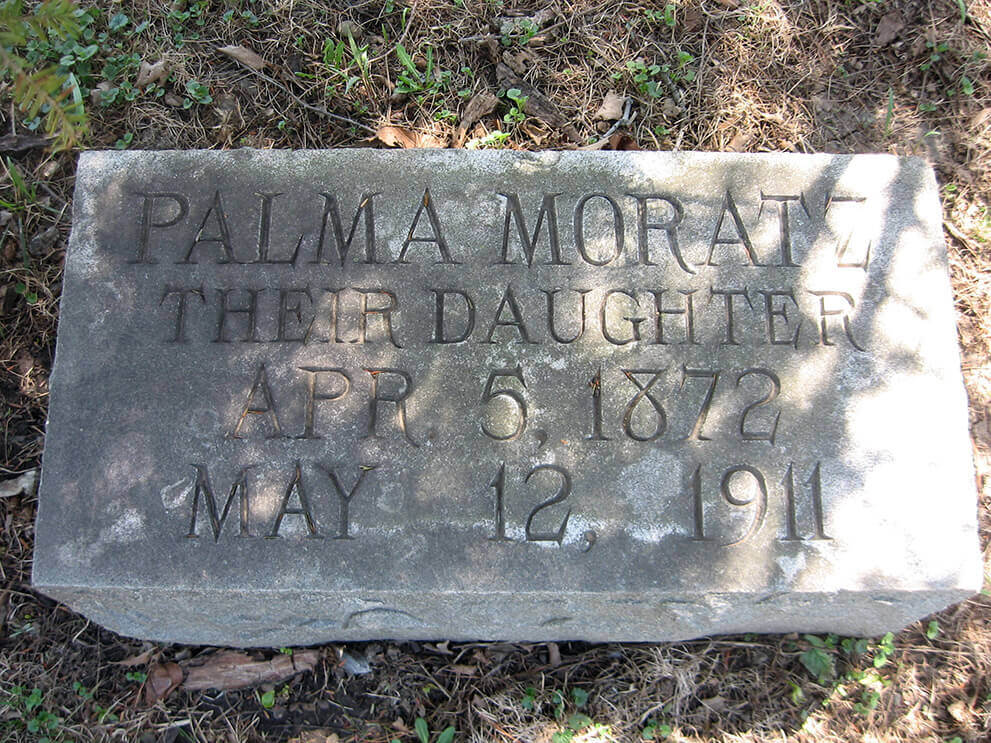Palma Moratz was born on April 6, 1879 in Bloomington, IL to German-born parents, Hermann and Emilie Eisner Moratz. Her father, Hermann, immigrated to the United States in 1867 and her mother, Emilie, followed in 1869 with their son Paul. It is not known exactly why the Moratz family left Germany but perhaps they were seeking better economic conditions. It is known however that Hermann served in the 1866 war against Austria only a few years before immigrating so perhaps that event influenced his decision to migrate. In Bloomington he worked as a carpenter in a shop across the street from the family home located at 1106 S. Main Street.
Like many other German immigrants, Palma and her family remained true to their German roots in nearly all aspects of life. By 1870 Bloomington’s population was 13% German and at that time, German society presented a diverse array of institutions, including Protestant and Catholic churches and a Jewish temple. German language schools, a German language newspaper (The Bloomington Journal), and a variety of German social clubs were aspects of the community as well. They undoubtedly spoke German quite regularly at home and in public.
It is not known for sure exactly which German social clubs the Moratz family belonged to but it is thought that one of them was the Turnverein. The Turnverein was founded in Germany in 1811 as a national organization to promote physical fitness through activities such as gymnastics. The founder, Ludwig Jahn, believed that “physical education was important to national health and strength.” The club also sponsored libraries and lectures and had social clubrooms where members of the German community could gather and socialize. Family picnics and other celebrations were also put on by the club to encourage members of the German community to interact with each other.
The Turnverein was founded in Bloomington in April, 1855. To become a member a person had to be either from Germany or the child of a German-descended member. Women were considered associate members and their spouses that were not German were allowed to become social members. Palma and her six brothers, (Paul, Richard, Max, Theodor, Clemens, and Arthur) probably spent many weekends at Turner picnics and parties which were open to all members of the family including women and children. Many of these events were held at the local Turner Hall which was designed by George Miller and was located on South Main Street.
Like many other Germans who lived in Bloomington, Palma was very active in clubs and organizations. According to her obituary, she was a member of the Order of the Eastern Star chapter #50, a member of the Judea White Shrine #10, and a member of the First Baptist Church in Bloomington.
October 6, 1891 was a big day for Palma. She was chosen to portray Miss Germania opposite Miss Columbia (portrayed by Miss Riebsane, daughter of a Turnverein official) at Bloomington’s first German Day festival. On German Day all McLean County German clubs and lodges united in one giant festival. This festival celebrated the founding of the first German settlement in America at Germantown, Pennsylvania in 1683 and German contributions to America. Dressed in traditional German clothes and bearing a German flag, Palma stood on the viewing podium during the parade and shook hands with Miss Columbia who bore an American flag, to symbolize the friendship and community between the old country and the new country. This celebration in Bloomington would become an annual event in which both Germans and non-Germans in the community would participate.
Palma received her childhood education in Bloomington and studied Elocution at the Emerson School of Oratory and Elocution (today known as Emerson College). In 1905, she was teaching elocution at the local Marie Litta Conservatory. Students paid $3.00 to be part of her class for 60 minutes a week and $10.00 for a one-hour weekly private lesson in the arts of public speaking and reading out loud. Today, those same lessons would cost $70.00 for 60 minutes a week and $236.00 for a one-hour weekly private lesson. However in 1909 she is listed in the city directory as a saleslady at the dry goods and notions store of Charles J. Northrup. It is not known if she continued to teach at the Maria Litta Conservatory during this time.
In the spring of 1911 Palma suffered a collapse. For the last seven weeks of her life, her condition continued to deteriorate while she was hospitalized at St. Joseph’s Hospital in Bloomington. On May 12, 1911 she succumbed to her illness, which was listed as pneumonia in cemetery records. Her funeral was held at the home of Paul Moratz, local architect and her oldest brother. She was buried near her mother at Evergreen Memorial Cemetery in Bloomington. Her father, Hermann, followed her in death only four days later and is buried next to her.
